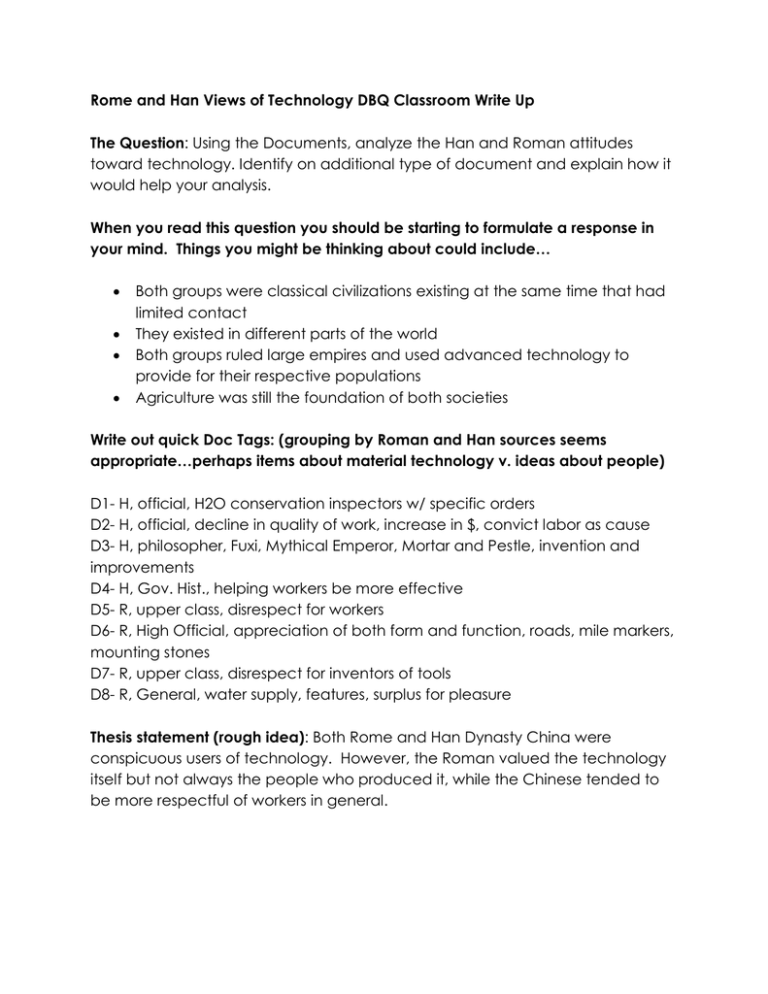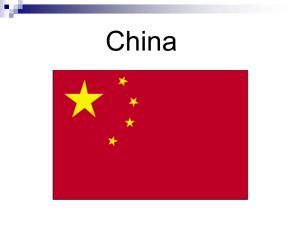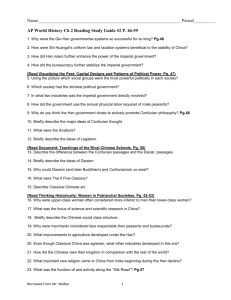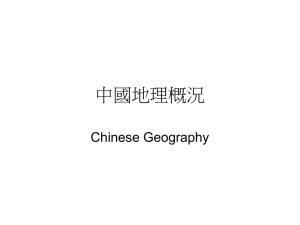Rome and Han Views of Technology DBQ Classroom Write Up The
advertisement

Rome and Han Views of Technology DBQ Classroom Write Up The Question: Using the Documents, analyze the Han and Roman attitudes toward technology. Identify on additional type of document and explain how it would help your analysis. When you read this question you should be starting to formulate a response in your mind. Things you might be thinking about could include… Both groups were classical civilizations existing at the same time that had limited contact They existed in different parts of the world Both groups ruled large empires and used advanced technology to provide for their respective populations Agriculture was still the foundation of both societies Write out quick Doc Tags: (grouping by Roman and Han sources seems appropriate…perhaps items about material technology v. ideas about people) D1- H, official, H2O conservation inspectors w/ specific orders D2- H, official, decline in quality of work, increase in $, convict labor as cause D3- H, philosopher, Fuxi, Mythical Emperor, Mortar and Pestle, invention and improvements D4- H, Gov. Hist., helping workers be more effective D5- R, upper class, disrespect for workers D6- R, High Official, appreciation of both form and function, roads, mile markers, mounting stones D7- R, upper class, disrespect for inventors of tools D8- R, General, water supply, features, surplus for pleasure Thesis statement (rough idea): Both Rome and Han Dynasty China were conspicuous users of technology. However, the Roman valued the technology itself but not always the people who produced it, while the Chinese tended to be more respectful of workers in general. Opening Paragraph: (thesis in bold) In the early centuries of the Common Era, Roman Civilization in Europe and the Han Dynasty Chinese in East Asia existed at roughly the same time during prolonged periods of peace which allowed for the development and refinement of advanced technologies. Both of these classical civilizations used technology for a variety of purposes to maintain their empires and provide for their citizens. Elites in both civilizations valued and understood the benefits of advanced technology in a variety of areas. However, the Chinese show a greater sensitivity and respect for the common man where the Romans seemed to value the technology itself but not the workers, viewing them as base and unsophisticated. Body Paragraphs (Han China): In Han Society technology was valued on many levels. The vast population of China required effective water management technologies to maintain agricultural infrastructure in order to produce surplus food for urban centers. The Chinese made significant investments of human capital and resources to make sure irrigation systems ran with minimal interruption (D1). The Chinese tended to hold the view that those in leadership positions had a responsibility to assist and help the working class with their labors by supporting technological innovation (D4). The Chinese also valued quality of work, fostered by the belief that craftsmen developed superior products to those derived from forced labor (D2). The cultural bias toward leadership supporting the people was so pronounced that it worked its way into Chinese Mythology at times, showing wise emperors as inventing technologies that assisted the population (D3). These attitudes would make sense in the context of Asian society, given regional influences of Confucianism and Taoism. Confucianism stresses order in society and respect for one’s position within the group, while Taoism’s focus is harmony within society and with the natural environment. Both ideas may be reflected in the Chinese sources provided here, as Chinese elites would tend to support these philosophies (POV). It would greatly assist our analysis of Chinese views of technology to have access to a document containing the point of view of a Chinese laborer or peasant. A document of this kind might allow for a better understanding as to if the lower classes felt valued by the elites in their society (OD). Body Paragraphs (Rome) (Different Style of Organization Used): The Romans were perhaps even more gifted with technology related to civil engineering than the contemporary Chinese. Over several centuries the Romans conquered a vast and culturally diverse empire in the Mediterranean Region of the Western World. Their ability to control this empire, provide services to their citizens and foster trade and commerce relied on advanced technologies such as roads and aqueducts. Roman roads served several purposes. They allowed for efficient movement of military troops, assisted in effective trade and connected urban centers to core areas of the empire. The Romans took pride not only in these advantages but also made special efforts to make sure the roadways were esthetically pleasing and helpful to the population (D6). Building roadways that were straight, overcame obstacles and offered features such as mounting blocks, mile markers and speed bumps offered a sense of pride to many Romans (D6). Providing water for large urban populations was another challenge the Romans used advanced technologies to address. The Romans found satisfaction in the ability to use aqueducts to provide enough water for basic needs as well as pleasure (D8). Surplus water could be used for bathhouses, fountains and the individual homes of the wealthy citizens. Positive attitudes toward technology would make sense as they reflect or have connections to elites in the society. These individuals would see direct benefits from the implementation of items such as roads and water management technologies (POV). Unlike the Chinese, the Romans did not seem to be concerned about helping workers. Evidence suggests that the Romans viewed workers that developed or implemented technologies in a disrespectful or degrading manner (D5) (D7). This difference in viewpoint could be due to the greater use of slave labor in Roman society when compared to the Han, perhaps leading to a lesser value placed on people from the working class (POV). As with the sources from China, it would be helpful to have a document from the point of view of an average citizen in Roman society. This kind of source would offer evidence to show if the disrespect toward the working class was pervasive through the whole society or was contained primarily in the upper classes (OD). Conclusion: (can be sued to refine the thesis statement) Roman and Han Dynasty Chinese civilizations valued the benefits of advanced technology. They took great care to build and maintain these technologies for the benefit of those in their societies. However, the two groups had dramatically different attitudes toward the individuals that developed and implemented technology in these advanced classical civilizations. Remember to go back to your “basic core” grading items on the AP rubric: Has an acceptable thesis Is organized and well written Uses all the documents Provides explanation and analysis of point of view of authors Grouping of documents in appropriate ways Proposes additional documents that would be helpful These items are a MUST…but doing the well can earn you bonus points.





